Spaceflight Radiation Health Program
at JSC
Early in the evolution of the space program, radiation was recognized as a hazard to
humans traveling in space. Monitoring of crew radiation exposures was initiated during
Project Mercury and has continued through the current Shuttle Program.
The space radiation environment is significantly different from that found
terrestrially. Space radiation primarily consists of high-energy charged particles, such as
protons, alpha and heavier particles, originating from several sources, including galactic
cosmic radiation, energetic solar particles from solar flares and trapped radiation belts.
Some of these high-energy particles inflict greater biological damage than that resulting
from typical terrestrial radiation hazards. Crew exposures can easily exceed exposures
routinely received by terrestrial radiation workers. Increased knowledge of the composition
of the environment and of the biological effects of space radiation is required to assess
health risks to astronaut crews.
Future expeditions into interplanetary space will place crews at increased risk of exposure compared to the current short duration low-Earth orbit (LEO) missions. Long duration exploratory class missions will not benefit from the protection from Galactic Cosmic
Radiation (GCR) and energetic solar flare protons afforded by the Earth's geomagnetic field. Astronaut exposure to GCR within an unprotected or thinly shielded spacecraft during solar minimum
is sufficient to exceed current astronaut exposure guidelines.
Energetic Solar Particle
Events (SPEs) present an additional source
of risk. These events are unpredictable in nature
and potentially
life threatening to an inadequately protected crew. Unshielded
exposure to large
solar particle events may lead to serious acute
health effects. To minimize the risk to the crew,
the magnitude
and dynamics of the potential radiation environment must be considered
when
performing spacecraft and mission design.
For terrestrial radiation workers, additional protection against
radiation exposure can be provided through increased shielding.
Additional shielding against space radiation exposure may not
be practical or efficient. Galactic cosmic radiation is extremely
penetrating. Dose equivalent exposure rates behind thin shielding
are reduced rapidly at first, but plateau with increasing thickness.
Thus, thicker shields become less efficient. The additional mass
added purely for reducing radiation exposures becomes a substantial
mass penalty for transportation vehicles and therefore may dramatically
increase mission cost.
The Johnson Space Center (JSC) leads the research and development
activities necessary to address the health effects of space radiation
exposure to astronaut crews. These activities range from quantification
of astronaut exposures to fundamental research into the biological
effects resulting from exposure to high-energy particle radiation.
The Spaceflight Radiation Health Program seeks to balance the
requirements for operational flexibility with the requirement
to minimize crew radiation exposure.
The radiation environment may be classified into three sources
of radiation: trapped radiation, galactic cosmic radiation (GCR)
and energetic solar particle events (SPE). Each source is characterized
by a different composition of particle energies and fluence. Many
of these sources are modulated during the course of the solar
cycle.
Most manned spaceflight missions have been conducted within the
protection of the Earth's magnetic field. The geomagnetic field
shields the crews from large SPEs and a significant portion of
the GCR. For the low-Earth orbiting missions which have typified
the U.S. manned space program, the largest fraction of the radiation
exposure received has resulted from passage through a region known
as the South Atlantic Anomaly (SAA). The remainder of the exposure
is attributed to high-energy galactic cosmic radiation. During
the Apollo lunar missions, astronauts traversed through the trapped
radiation belts into the unprotected realm of free space outside
the geomagnetosphere. These excursions into cislunar space placed
the astronauts at risk of receiving life threatening radiation
exposures if a large SPE were to occur. Fortunately, no major
solar proton events occurred during these missions.
Trapped Radiation
The Earth's magnetic field is responsible for the formation of
the trapped radiation belts that surrounds the Earth. Electrons
and protons are trapped in regions starting above the atmosphere
and extending to a distance of 10 to 12 Earth radii. Charged particles
travel through these zones spiralling around the magnetic field
lines, oscillating back and forth between "mirror points"
located in opposite hemispheres. Figure 1.
illustrates the distribution of high and low energy protons and
electrons around the Earth.
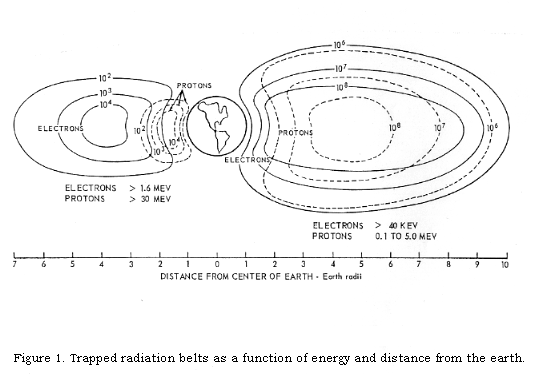
The magnetic axis of Earth is tilted approximately 11 degrees
from the spin axis and is slightly offset from the center of the
Earth. As a result of the shift and tilt of the magnetic field,
the trapped proton belts extend down to the atmosphere in a region
located over South America and the South Atlantic Ocean. This
region is known as the South Atlantic Anomaly (SAA). Low inclination
flights typically transit a portion of the SAA during six or seven
consecutive orbits each day. Figure 2.
shows the exposure rate as a function of orbital position for
a 28.5 degree orbit. The SAA is the primary source of radiation
exposure for the shuttle and the proposed Space Station Freedom.
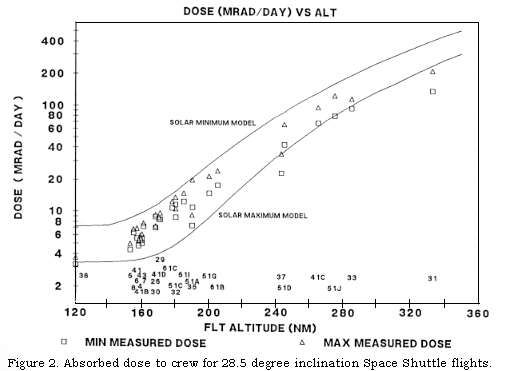
The proton spectra and fluence are strong functions of altitude.
At the higher altitudes, the greater portion of crew exposures
is received during transits through the SAA as a result of greater
trapped proton fluence levels. At lower altitudes, the protons
in the SAA interact with the residual atmosphere. Some of the
protons are lost and contribute to an anisotropic distribution
of protons. Over a factor of two difference exists between the
proton flux from the east compared to the flux from the west.
The anisotrophy in particle flux will be an important factor for
Space Station.
In addition to altitude, the integrated dose is a function of
orbital inclination and solar cycle. The dose received by the
crew during low inclination (28.5 degree) low-Earth Orbits (LEO)
is illustrated in Figure 3. The Space
Station is planned to operate at this orbital inclination between
200 and 270 nautical miles (370 to 500 km). Increases in solar
activity expand the atmosphere and increase the losses of protons
in LEO. Therefore, trapped radiation doses in LEO decrease during
solar maximum and increase during solar minimum.
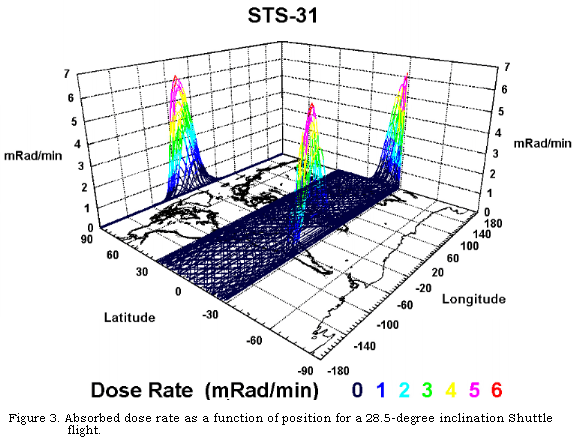
Trajectories of low inclination flights do not pass the regions
of maximum intensities within the SAA. Although high inclination
flights pass through the SAA maximum intensity regions, less time
is spent in the SAA than low inclination flights. Thus crews in
high inclination flights receive less net exposure to trapped
radiation than in low inclination flights for a given altitude.
This is illustrated in Figure 4., which
depicts the location of the SAA as measured by internal equipment
on the shuttle. Low inclination flights will not transit the SAA
south of 28.5 degrees south latitude. High inclination flights
transit between North and South 58 degrees.
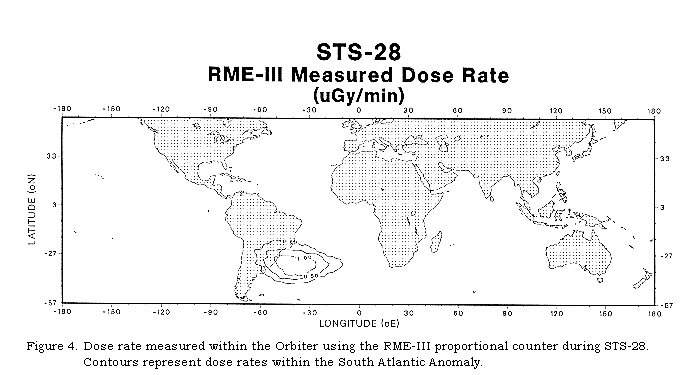
Galactic Cosmic Radiation (GCR)
Galactic cosmic radiation originates from outside the solar system.
It consists of ionized charged atomic nuclei from hydrogen (87%)
and helium (12%) to uranium (trace) and are characterized by extremely
large kinetic energies (up to several thousand GeV
per atomic mass unit (amu)). The integral flux of four isotopes
at solar minimum conditions is depicted in Figure 5.
These particles are distributed isotropically and found in relatively
low fluence.
The effect of solar activity on the integral GCR flux is also
shown in Figure 5. During periods of
solar maximum activity, the interplanetary magnetic field generated
by the sun provides some protection to the inner solar system,
decreasing GCR integral intensity. Higher energy particles are
not appreciably attenuated, lower energy fluence is significantly
reduced. The integral GCR dose rate in free space is approximately
a factor of 2.5 higher at solar minimum than at solar maximum.
During solar minimum, the unshielded dose to the blood forming
organs (BFO) is approximately 60 rem/year.
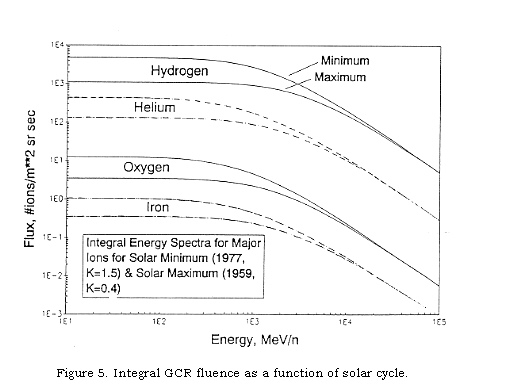
Due to its high energy, GCR is very penetrating. Thin to moderate
shielding is effective in reducing the projected equivalent dose
rate, but as shield thickness increases, shield effectiveness
drops. This is the result of the production of a large number
of secondary products including neutrons from nuclear interactions
between the GCR and shield nuclei. Figure 6.
illustrates the annual BFO dose equivalent as a function of different
shield materials.
The geomagnetic field also deflects many of the lower energy GCR
components. This protection is primarily a function of latitude,
as is shown in Figure 7. Compared to
low inclination orbits, higher inclination orbits are exposed
to increased GCR levels as the spacecraft transits the higher
latitudes. In the proposed Space Station orbit, the magnetic field
provides a factor of 10 reduction in total GCR exposure relative
to the free space environment. During geomagnetic storms, higher
GCR exposures may be experienced at lower latitudes. Little increase
in GCR is realized as the altitude increases.

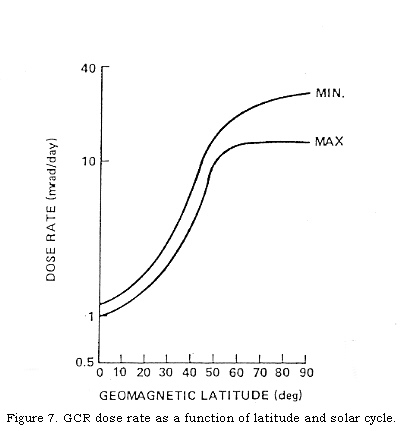
Solar Particle Events (SPEs)
Solar particle events (SPEs) are injections of energetic electrons,
protons, alpha particles and heavier particles into interplanetary
space during solar flares. During periods of maximum solar activity,
the frequency and intensity of solar flares increase. Most flares
do not present a significant hazard, because they are either too
small to inject significant numbers of energetic solar particles
or they occur at solar longitudinal positions that are unfavorable
for the direct transfer of particles to the Earth along interplanetary
magnetic field lines. However, flares or rapid sequences of large
flares that are orders of magnitude greater in intensity than
most flares, are of particular concern for generating very large
energetic SPEs. These solar proton events generally occur only
once or twice a solar cycle. However, during the 22nd solar cycle,
four comparable extremely large flares occurred in a 4 month period.
The Oct. 19, 1989 event was the largest.
Each solar particle event is characterized by the total number
of particles and the particle energy spectrum. The spectra of
three of the largest proton events are depicted in Figure 8.
The intensity and spectral distribution of SPEs have a significant
impact to shield effectiveness. Figure 9.
represents the shielding effectiveness for these large SPEs.

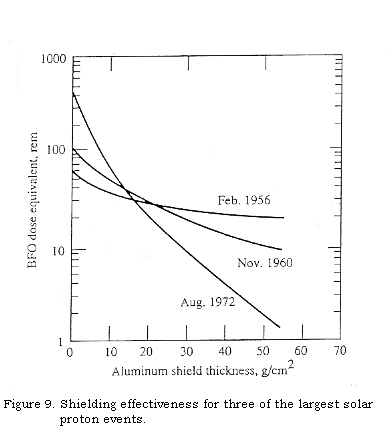
Several factors make accurate prediction of SPEs difficult. First,
solar flares occur without much warning. The magnitude and intensity
of a flare are difficult to determine until the event is in progress.
The directional emission of particles from the sun further complicates
predictions. Since SPEs are relatively directional, SPEs sensed
by a terrestrial network may not threaten a Martian transit mission,
and conversely, a flare injection of energetic solar particles
that threatens a Martian transit mission may not produce particles
at Earth.
SPEs pose the greatest threat to unprotected crews in polar, geostationary
or interplanetary orbits. To date, the greatest threat to significant
exposures to astronauts existed during the Apollo Program. Figure 10.
illustrates the variation in timing and magnitude of SPEs that
occurred during the course of the Apollo Program. The calculated
dose for crewmembers within the command module, within the lunar
module or in a space suit performing EVA is represented for each
flare. As can be seen in the figure, it is only fortuitous that
no significant SPEs occurred during the lunar missions.
Fortunately, most SPEs are relatively short-lived (less than 1-2
days), which allows for relatively small volume "storm shelters"
to be feasible. To minimize exposure, the crew would be restricted
to the storm shelter during the most intense portion of the SPE,
which may last for several hours. Storm shelters with shielding
of approximately with 20 g/cm2 or more of water equivalent material
will provide sufficient shielding to protect the crew.
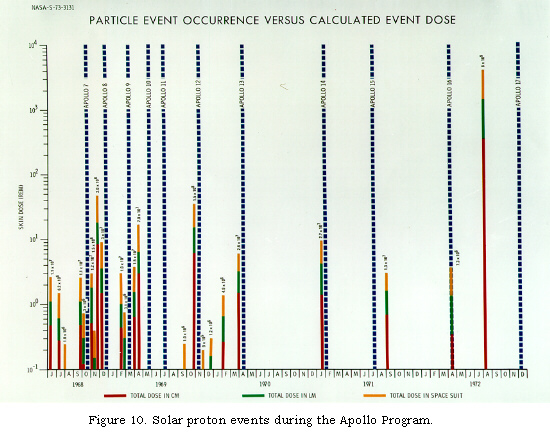
Manmade Sources
Additional environmental hazards may be present from the use of
manmade sources. These hazards may be in the form of exposure
resulting from medical investigations, radioisotopic power generators,
or small sources for experiments. Lunar and Martian missions may
include either nuclear reactors for power or propulsion purposes
that will contribute to crew radiation health concerns.
Low Earth Orbit Environment
Current missions are restricted to LEO. Figure 11.
shows data taken during the high inclination STS-28 flight and
illustrates the contributions of the three natural sources of
radiation. The GCR component varies cyclically with maximums at
the extreme northern or southern portion of the orbital track.
Minimums correspond to transits of the geomagnetic equator, where
the spacecraft experiences the maximum geomagnetic protection
from GCR. At periodic intervals large spikes in the exposure rates
are encountered which correspond to passages through the SAA.
The largest spikes are passages through the regions of peak SAA
intensity; smaller peaks represent passage through the fringes
of the SAA. A unique feature of this data is the effects of a
solar particle event measured in LEO. Peaks in the dose rate attributed
to the SPE occur at the extreme northern or southern portions
of the orbital track. Whereas the GCR and SAA components shown
in the figure are "typical" for high inclination flights,
the effects of SPEs on dose rates will depend upon a variety of
parameters.
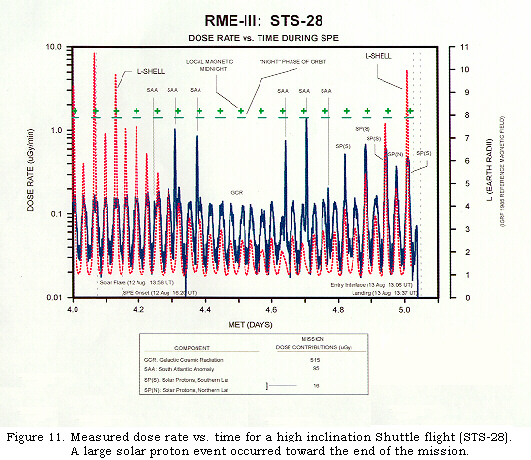
Astronauts have been classified as radiation workers and therefore
a program must exist to protect them from excessive radiation
exposure. The Presidential Executive Order 12196 requires all
federal agencies, including NASA, comply with Occupational Safety
and Health Administration regulations related to ionizing radiation
exposure. While NASA is required to follow OSHA regulations, no
OSHA standards exist for spaceflight. Terrestrial radiation exposure
guidelines provided in the Code of Federal Regulations (29 CFR
1910.96) are too restrictive for space activities and therefore
have been judged to be inappropriate. NASA can establish supplementary
standards for appropriate control of radiation for astronauts
in accordance with 29 CFR 1960.18. The following NASA requirements
serve as a basis for the implementation of the supplementary standard:
(1) that its use applies to a limited population, (2) maintenance
of detailed flight crew exposure records, (3) pre-flight hazard
assessment/appraisal, (4) planned exposures be kept As Low As
Reasonably Achievable (ALARA), (5) maintenance of operational
procedures and flight rules to minimize the chance of excessive
exposure and (6) man-made onboard radiation exposure complies
with 29 CFR 1910.96 except where the NASA mission/objectives cannot
be accomplished otherwise.
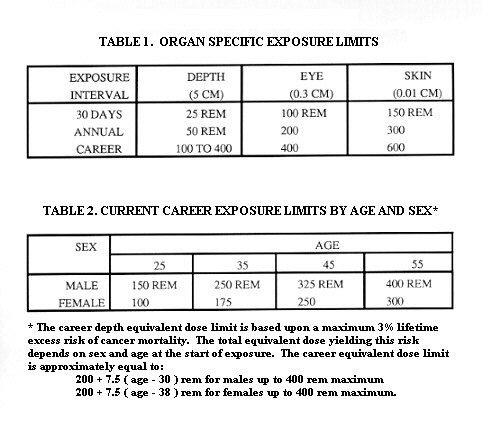 NASA has adopted the recommendations that the National Council
on Radiation Protection and Measurements (NCRP) presented in its
Report 98, "Guidance on Radiation Received in Space Activities"
(July, 1989) as the basis for the supplementary standard for spaceflight
crew radiation exposures. The maximum exposure limits are presented
in Tables 1 and 2. Whereas monthly and annual
limits primarily exist to prevent the short term physiological
effects of exposure, career limits exist to contain radiation
risk within a 3% increased lifetime cancer mortality. The recommendations
of the NCRP apply to activities in low-Earth orbit, such as Space
Station. Astronaut exposure limits are greater than those of terrestrial
radiation workers.
NASA has adopted the recommendations that the National Council
on Radiation Protection and Measurements (NCRP) presented in its
Report 98, "Guidance on Radiation Received in Space Activities"
(July, 1989) as the basis for the supplementary standard for spaceflight
crew radiation exposures. The maximum exposure limits are presented
in Tables 1 and 2. Whereas monthly and annual
limits primarily exist to prevent the short term physiological
effects of exposure, career limits exist to contain radiation
risk within a 3% increased lifetime cancer mortality. The recommendations
of the NCRP apply to activities in low-Earth orbit, such as Space
Station. Astronaut exposure limits are greater than those of terrestrial
radiation workers.
Recent information from reevaluation of atomic bomb survivor data
and other sources has provided impetus for further examination
of the acceptable limits of astronaut radiation exposure. Preliminary
recommendations from the NCRP evaluation of the new data suggest
that even lower career limits for astronauts may be warranted.
During spaceflight, crew exposures are monitored using passive
dosimeters. A new generation of radiation instrumentation is being
developed to assist in interpreting the crew radiation exposures.
Exposure from medical procedures and experiments are also determined
for each astronaut. Records of exposure both to medical examinations
and spaceflight are documented as part of the Spaceflight Radiation
Health Protection Program.
Under the Space Radiation Health Program, NASA sponsors many investigations
regarding space radiation research. Sponsored research typically
falls into one of three categories: Radiation Physics, Dosimetry,
and Radiobiology. An annual workshop for sponsored investigators
is provided each year to discuss the achievements for the past
year and direction of the upcoming year. The elements of the research
program are illustrated in Figure 12.
Efforts at JSC address all three areas.
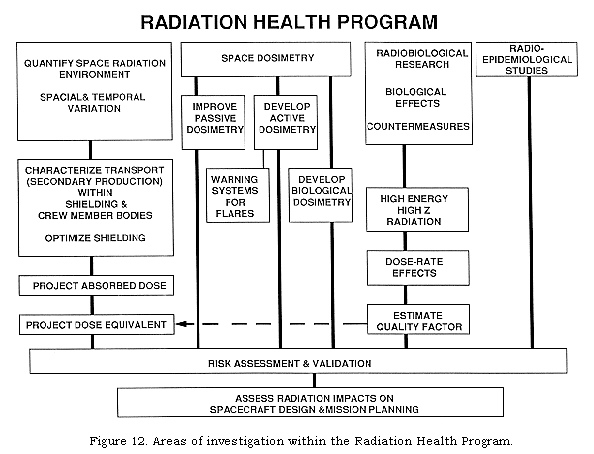
Advanced Radiation Monitors
Longer duration stays in the space radiation environment demand
improved dosimetric instrumentation to evaluate the true health
hazard to crews. The passive dosimetry currently used for shuttle
missions provides only part of the information needed to quantify
the crew effective dose equivalent. Two new instruments (TEPC
and CPDS) are being developed for use on the Space Station to
improve the crew radiation exposure risk estimation. These real-time
instruments will continuously telemeter radiation data to Mission
Control for monitoring the radiation environment. Prototypes of
the new instruments are being tested during shuttle missions.
The new Space Station instrumentation includes:
- Tissue Equivalent Proportional Counter (TEPC)
The TEPC, shown in Figure 13., is
a gas proportional counter that measures the LET
spectrum of the incident radiation in a simulated small volume
of tissue. From the LET spectrum and information provided in ICRP-60,
the appropriate radiation quality factor can be estimated. The
TEPC will be relocatable into any of the Space Station modules
or nodes. The TEPC also is being modified and tested for potential
flight opportunities with the Soviet Space Program. One version
is planned for use on the Soviet space station Mir, and a second
version is planned for inclusion as a radiation instrument on
a probe to Mars. Other versions of the TEPC are being considered
for routine use on commercial airline flights to assess the radiation
dose from galactic cosmic radiation to the flight crews.
- Charged Particle Directional Spectrometers (CPDS)
The CPDSs will measure the flux of all trapped, galactic cosmic
radiation and secondary radiation as a function of time, charge,
energy and direction. The CPDS is a semiconductor energy loss
spectrometer. Incident radiation penetrates a stack of semiconductor
wafers followed by a Cerenkov detector. The energy lost to each
wafer is quantified and summed. Total particle energy and particle
charge are deduced from these measurements. A 60 degree solid
angle cone of acceptance of incoming radiation is achieved using
coincidence circuitry and instrument geometry. Position Sensitive
Detectors will provide angular resolution of the incident radiation
path within the detector. Two versions of the CPDS are planned:
one for internal use and one for external use. The external instrument
will consist of a single fixed location unit with three independent
detectors oriented in specific directions. The internal unit can
be relocated within the Space Station modules or nodes. The external
CPDS will collect data for accurate mapping of the space radiation
environment, building improved crew dose projection tools and
serving as a control for relocatable internal instruments. The
internal CPDS will define the types of radiation inside the Space
Station for assessing the penetration capability of the radiation.
A prototype of the internal instrument is shown in Figure 14.
- Passive Dosimetry - Improved passive dosimetry,
similar to that currently used on the shuttle, will be used on
Space Station. These include personal passive dosimetry for monitoring
the absorbed dose to each astronaut and passive area monitors,
which will be located at specific locations throughout the Space
station to measure the absorbed dose distribution.
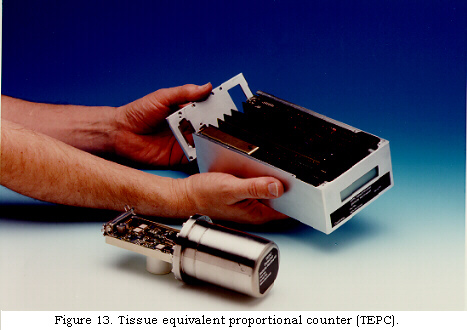
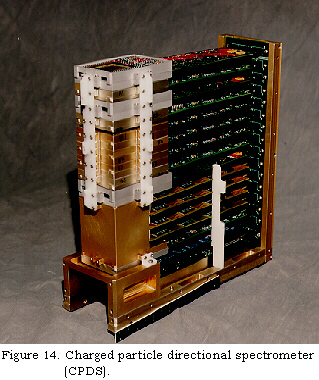
Flight Experiment Support
Radiation flight experiments are frequently flown as part of the
Shuttle Detailed Supplementary Objectives (DSOs) Program. These
experiments include flight testing the radiation monitor prototype
units as well as other monitoring devices.
Data from Space Station prototype spectrometers also have been
used to assist investigations into Single Event Upsets (SEUs)
in shuttle computers. SEUs are events resulting from charged particles
interacting within semiconductor devices that generate enough
charge to change the state of flip-flop circuits, such as computer
memory. These are known as "soft" upsets and can be
corrected by reloading programs or data. "Hard" upsets
result from physical damage to a circuit element from the incident
radiation and is permanent.
Some medical procedures use radioactive tracers to track physiological
changes as crewmembers adapt to the weightless environment. These
hazards are reviewed by the Human Research Procedure and Protocol
Committee. Crew doses are estimated for the procedures and documented
in their health records.
Environmental Models
Current models of the trapped radiation environment (AP8, AE8)
are over 20 years old. These are static models and do not take
into account the dynamics that can occur within the trapped radiation
belts. The Space Station platform will provide continuous coverage
over many years to enable data to be collected in which to improve
the models and facilitate improved projections of crew doses.
Data from the Space Station active monitors will be used to update
and verify models of both the trapped radiation environment and
the cosmic radiation environment. Improvements in the models to
accommodate transients as well as to correct for the physical
shift of the SAA will be incorporated. Data gathered from prototype
development flights has been used to provide a better understanding
in the current structure of the LEO trapped radiation hazard.
Health Risk Assessment
The penetration of radiation within the body is being studied.
Human equivalent densimetric phantoms are used to analyze the
dose at different depths within the body. This information is
correlated with transport codes and human anatomical computer
models. These evaluations will lead to the ability of performing
organ specific dose estimates and of estimating the net increased
risk of cancer for the crew.
Fundamental research into the effects of high-LET radiation also
is performed at the Johnson Space Center. A variety of cell tissue
cultures are irradiated with both on-site (gamma radiation, Co-60)
and off-site (proton and heavy particle accelerators) sources.
The transformation toward cancer within these samples is monitored
and the correlation of observed biological effects with received
dose is determined. These types of studies are pivotal in the
development of exposure standards for astronauts. Research in
this arena may lead to the development of a biological dosimeter
and/or countermeasures. Biological dosimeters will use biological
media directly to measure biologically effective doses instead
of relying on extrapolation from physical dosimeter measurements.
Monitoring astronaut radiation exposures has been a key requirement
for spaceflight since Project Mercury. Current Space Shuttle operations
require a variety of activities. Preflight activities include
projecting mission doses and reviewing of crew health records.
Dosimetry, shown in Figure 15., for the
crew and Orbiter are prepared and shipped to the Kennedy Spaceflight
Center (KSC) for integration into the Orbiter. During each mission,
continuous radiological support and space environment monitoring
are provided from within the Mission Control Center. Postflight,
crew dosimetry is retrieved and analyzed and crew exposure records
are updated. This process is depicted in Figure 16.
Space Station operations will follow similar functional responsibilities.
One of the most significant differences will be the utility of
real-time active radiation monitoring on the Space Station. This
feature will provide significant improvement to operations by
providing exposure monitoring during missions.
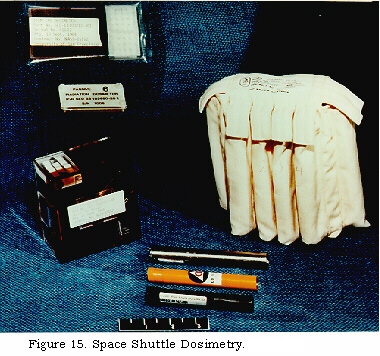

The Spaceflight Radiation Health Protection Program is administered
from within the Space and Life Sciences Directorate. The general
responsibilities of the respective divisions are summarized below.
Medical Sciences Division
- Supports the mission Flight Surgeons in advising the Flight
Director during radiation contingencies;
- Maintain astronaut health records including documentation
of both mission and medical radiation exposure histories;
- Provide health risk analysis;
- Support payload safety reviews for Shuttle spaceflight experiments;
- Establish radiation health requirements for manned spaceflight;
- Provide integration support to Space Station; Develop radiological
operational support training programs;
- Conduct and administer fundamental research into the biological
effects of space radiation.
Solar System Exploration Division
- Provide real-time operational radiological support during
manned missions;
- Provide operational dosimetry support for crews and manned
vehicles;
- Provide preflight mission crew and equipment exposure projections;
- Improve and develop engineering tools used for space radiation
exposure analysis;
- Develop advanced radiation monitoring equipment.
 As NASA plans for future missions to the Moon or Mars, radiation
exposure remains one of the limiting technological issues. Apollo
missions were fortunate to avoid random solar proton events through
short mission duration in Figure 17. Future
missions will involve longer stays,
making simple avoidance
less practical. Lunar stays to 6 months
and round trip duration of
3 years for Martian missions are being
considered. Accurate
prediction of solar particle events still
is not possible today. In addition, the biological effect from
long term exposure to high energy galactic cosmic radiation is
not well understood. Current exposure guidelines will be exceeded
unless adequate shielding is provided.
As NASA plans for future missions to the Moon or Mars, radiation
exposure remains one of the limiting technological issues. Apollo
missions were fortunate to avoid random solar proton events through
short mission duration in Figure 17. Future
missions will involve longer stays,
making simple avoidance
less practical. Lunar stays to 6 months
and round trip duration of
3 years for Martian missions are being
considered. Accurate
prediction of solar particle events still
is not possible today. In addition, the biological effect from
long term exposure to high energy galactic cosmic radiation is
not well understood. Current exposure guidelines will be exceeded
unless adequate shielding is provided.
Nuclear technology may be used to enhance these missions, adding
to the radiation protection concerns. Nuclear power plants on
the lunar surface may be required to overcome the energy storage
challenges resulting from 2 week duration lunar nights. Substantial
savings in travel time and/or in propellant launched into orbit
for Martian missions may necessitate the use of nuclear thermal
propulsion. Although nuclear sources increase radiation risk to
astronauts, overall mission reliability, success and safety may
be increased. Johnson Space Center will be actively involved in
these issues to ensure crew health.
Johnson Space Center is the focal point within NASA for crew radiation
health protection. A comprehensive range of activities by JSC
engineers and scientists ranging from measuring biological effects
to physical environmental model development, is being conducted
to improve the quantitative understanding of risks to astronauts
due to radiation exposure during spaceflight. Special instrumentation
provide the means to quantify crew doses. Operational support
for current missions and projected support for future exploration
class mission will continue to be the function of the Spaceflight
Radiation Health Protection Program at Johnson Space Center.
Several terms are frequently used to describe or quantify radiation
exposure and are defined as follows:
RAD - The absorbed dose, RAD, is the amount of energy absorbed
from radiation per mass of material (1 RAD = 100 ergs/g). The
SI unit for absorbed dose is the Gray (1 Gray (Gy) = 100 Rad).
LET - Linear Energy Transfer quantifies the amount of energy
deposited per unit length of particle track. This factor increases
with the square of the charge and inversely proportional to the
energy of the radiation particle.
QUALITY FACTOR - Is a function of the particle LET, which is determined
by the charge and energy of radiation particles. This factor accounts
for the differences in biological effectiveness of different particles
and is used to convert an absorbed dose into a dose equivalent.
Currently, values for the quality factor may range from 1 to 20.
Quality factor values as high as 100 may be deemed appropriate
as additional research continues.
REM - The biological equivalent dose, REM (Roentgen equivalent man),
is the absorbed dose adjusted for biological effectiveness of the
particular type of radiation. It is the product of the absorbed dose
and quality factor. The SI unit for biological equivalent dose is
Sieverts (1 Sievert (Sv) = 100 Rem).
- Rem = Rad X Quality Factor
- Sievert = Gray X Quality Factor
eV - The kinetic energy of charged particles is measured
in units of electron Volts (eV). Multiples of eV are frequently used:
- keV = 1000 eV,
- MeV = 1,000,000 eV,
- GeV = 1,000,000,000 eV.
Benton, E.V., Editor, "Space Radiation", Nuclear Tracks
and Radiation Measurements, Vol. 20 No. 1, Pergamon Press New
York, January, 1992.
Benton, E.V. and J.H. Adams Jr., Editors "Galactic Cosmic
Radiation: Constraints on Space Exploration", Nuclear Tracks
and Radiation Measurements, Vol. 20 No. 3, Pergamon Press New
York, July, 1992.
Johnson, A.S., G.D. Badhwar and C. Yang, "Space Station Radiation
Dosimetry and Health Risk Assessment", 23rd ICES, SAE 932212,
July 1993.
McCormack, P.D., C.E. Swenberg and H. B�cker, editors, Terrestrial
Space Radiation and Its Biological Effects, NATO ASI Series,
Series A: Life Sciences, Vol. 154, Plenum Press, New York, 1988
.
Nachtwey, D.S. and T.C. Yang, Radiological Health Risks for Exploratory
Class Missions in Space, Acta Astronautica, 23:227-231, 1991.
NASA Life Sciences Strategic Planning Study Committee, "Exploring
the Living Universe, A Strategy for Space Life Sciences",
Final Report, F.C. Robbins, Chairperson, NASA, June 1988.
Robbins, D.E. and T.C. Yang, "Radiation And Radiobiology",
Chapter 20, in Space Physiology and Medicine, A. Nicogossian,
C. Huntoon and S. Pool eds., third edition (in press), Lea and
Febiger, Inc., Philadelphia, PA, 1993. Second edition, 1989.
Wilson, J.W., L.W. Townsend, W. Shimmerling, G. Khandelwal, F.
Khan, J. Nealy, F. Cucinotta, L. Simonsen, J. Shinn and J. Norbury,
"Transport Methods and Interactions for Space Radiations,
NASA Reference Publication 1257 (NASA-RP-1257), December, 1991.











 NASA has adopted the recommendations that the National Council
on Radiation Protection and Measurements (NCRP) presented in its
Report 98, "Guidance on Radiation Received in Space Activities"
(July, 1989) as the basis for the supplementary standard for spaceflight
crew radiation exposures. The maximum exposure limits are presented
in Tables 1 and 2. Whereas monthly and annual
limits primarily exist to prevent the short term physiological
effects of exposure, career limits exist to contain radiation
risk within a 3% increased lifetime cancer mortality. The recommendations
of the NCRP apply to activities in low-Earth orbit, such as Space
Station. Astronaut exposure limits are greater than those of terrestrial
radiation workers.
NASA has adopted the recommendations that the National Council
on Radiation Protection and Measurements (NCRP) presented in its
Report 98, "Guidance on Radiation Received in Space Activities"
(July, 1989) as the basis for the supplementary standard for spaceflight
crew radiation exposures. The maximum exposure limits are presented
in Tables 1 and 2. Whereas monthly and annual
limits primarily exist to prevent the short term physiological
effects of exposure, career limits exist to contain radiation
risk within a 3% increased lifetime cancer mortality. The recommendations
of the NCRP apply to activities in low-Earth orbit, such as Space
Station. Astronaut exposure limits are greater than those of terrestrial
radiation workers. 




